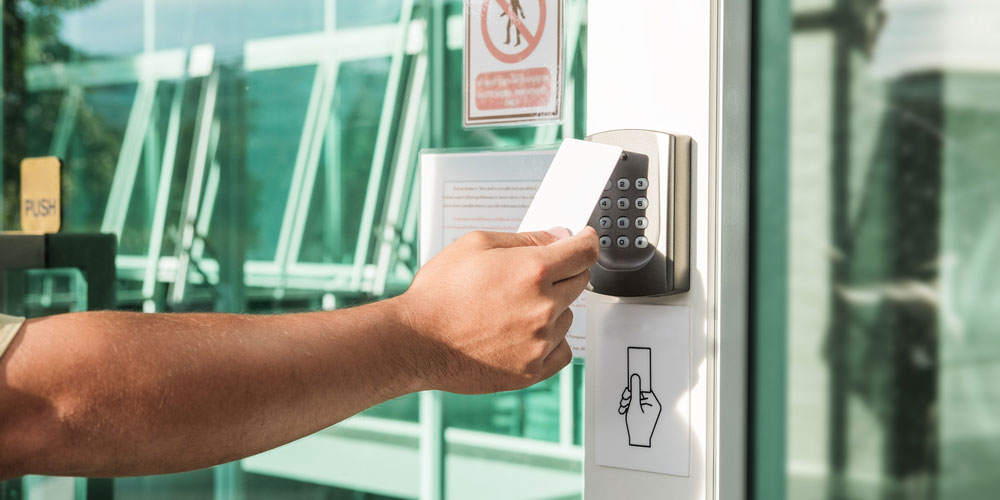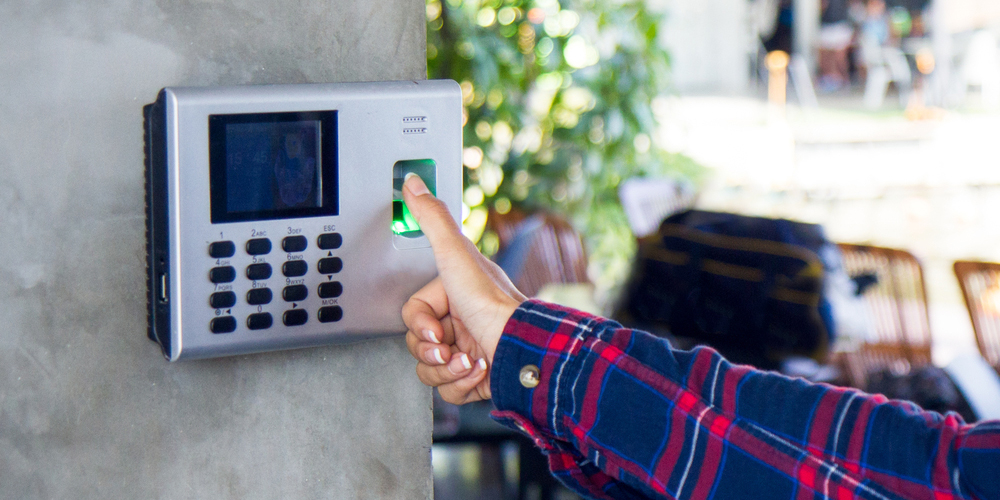Lock Blog
A resource for consumers, locksmiths, and security professionals
A resource for consumers, locksmiths, and security professionals

Whether you are constructing security protocols for the first time or rebuilding office security after a break-in, it is important to understand physical access control. This subject can get a bit technical, but we will try to keep all the concept explanations as straightforward as possible. If anything is unclear or you need any help installing the various types of physical access control, contact a commercial locksmith.
The main physical access control topics being covered:
Physical access control is a broad term that describes the network of security protocols used in and around a building. This type of security is most common in commercial, industrial, and research environments where access must be siloed between different classes of works. This allows for the protection of employees, visitors, data, machinery, etc.
Logical access control and physical access control both fall under the general category of access control. Physical access control differentiates itself from logical by strictly referring to the restriction of in-person access. Logical access control primarily refers to virtual access to a network, data, or devices.
The difference between physical access control and logical access control is the difference between your laptop being stolen and the files on your laptop being stolen. If you do not want people to physically touch something, you need physical access control. If you don’t necessarily need to touch it to access it, you need logical access control.
You can implement security cameras into physical access control for visual authentication and documentation. Instances, where security cameras do not protect your property, are when they are relied on as the sole criminal deterrent, the video data is not stored, or there is no method for immediate response to a threat.
In the security field, PACS stands for Physical Access Control System. This is a network of interconnected physical access control measures meant to cover the full spectrum of protection. These systems deter crime and theft, direct the flow of foot traffic, set levels of access, and provide the means for identifying potential threats by general usage documentation.
A physical access control system is more than just locks, keys, and protocols. A fully formed physical access control system integrates the disparate elements of your security, so each device communicates its usage data. You know when areas are accessed and by who. With the interconnectivity, you can remove and change access as needed and even set times where certain users will not have access or limit when doors can or cannot be opened.
A physical access control system will use some form of electronic lock hardwired into the electrical of the building. The type of lock will depend on your needs, concerns, and local laws. You may need fail-safe magnetic locks for ease of egress or fail-secure locks to make sure certain areas stay locked even during a power outage.
Physical access control keys include RFID fobs and cards, biometric readings, passwords, codes, mobile apps, etc. As opposed to a traditional metal key, these digital keys allow for the recording, monitoring of user access. Limiting and changing access is also more convenient than with traditional keys. And the risk of unauthorized key duplication is potentially eliminated.
A barrier can be as simple as a door or something more exotic, such as a vestibule. The barrier you need to use to prevent access to a given location will inform that type of locks can be used. Barriers are also used for perimeter security, such as gate checkpoints. Each barrier presents the opportunity to diversify security by using a different lock and key type.
An Access Control Server (ACS) is used to control access protocols and store information surrounding lock usage and any other additional documentation tools in a physical access control system. Your server interface is your primary means of controlling and reviewing your security. To get the most out of your physical access control system, you need centralized control software such as an ACS.
In order to implement the best physical access control, you should gain some familiarity with the various products and devices that make up these types of security networks. Once you have some physical access control examples, hopefully, you will be able to make a more informed decision on how to build out your physical access system.
An RFID lock uses a radio-frequency identification protocol, which merges the straightforward keyholder access of traditional locks and convenient access maintenance of electronic locks. If someone has an RFID token, they get access. But their behavior can be logged, and access privileges can be changed or removed easily. Think of it as a master key system with accountability controls.
Keys for these locks come in the form of tokens which can be fobs or key cards. These tokens can be tapped, swiped, or scanned for the lock to read their information. There is no equivalent of door lock cylinder replacement that is necessary because nothing about the key is wearing out the lock. And with a sturdy bolt assembly, the lock will last a long time without the need for servicing or repair.
Where an RFID lock uses a token to remove the key’s physical interaction with a lock, keypad locks do away with a key but require a code to be physically input. This adds a layer of convenience to the property owner who no longer needs to hand out, gather, and replace keys. Before you install a keypad door lock, take stock of your desired usage and security risks.
Different keypads can use different codes to restrict access. Alternatively, physical access control systems can also be configured so each person only needs to memorize one personal code, which will only open areas they have clearance for. How codes are stored or recorded may lead to personal codes being used by unauthorized individuals, as these keys can be copied covertly by overhearing or seeing them.

With biometric technology, you are the key. You give the machine a biological reading of some sort, whether it is a fingerprint, retinal scan, voice pattern, etc., and the machine treats that reading as an access code. These keys cannot be lost, left behind, or easily stolen. The most important part is recording the biometrics properly, so the lock opens every time.
Not all biometric locks are of the same quality, and lower-end products will have trouble with consistency. If users cannot consistently scan and enter areas they have access to, workarounds from these issues will end up diminishing security. If you are going to invest in biometric locks, make sure to purchase products built for longevity.
Security credentials can come in the form of employee badges with or without RFID capabilities. A credential system is ideal for physical access control systems that utilize security personnel who can double-check credentials. If you are using credentials for your physical access control, plan your access points where checks can take place.
Credentials can be completely divorced from the concerns of commercial door lock replacement if these badges or cards are not used as keys and are only used for manned checkpoints. However, any badges or identification that must be kept on hand or displayed while in a building is missing out on security functionality if it is not an RFID token.
A vestibule is a fancy term for an anti-chamber that can be installed on the perimeter of a building or in the interior. This room between rooms will have one door that leads immediately to another door. Often the first door can be opened by the entering user, but the second door can require the validation of someone inside the locked area.
This type of physical access control is meant to stagger the groups entering an area, and add additional security to highly sensitive areas in the building. This is a more severe form of physical access control and is rarely required for basic office security. A vestibule can easily be used as a checkpoint, but it does not need to be.
Turnstiles are often used in the lobbies of buildings to gain access to the elevators or a large campus-style workplace. Unless you have a full-body turnstile, these access points need to be treated as checkpoints. Locks are a necessity for these barriers, but they must open quickly so as not to slow the flow of foot traffic.
A turnstile is the lowest level of barrier security, but it acts as a good deterrent for criminals and unauthorized entry by displaying the intention to protect. As part of your building security assessment, determine if your workspace is large enough to warrant this type of specialty barrier. In most cases, a standard solid core door will be all you need to protect sensitive parts of a building.
A checkpoint is an access point overseen by security personnel. This can be done remotely through manned surveillance cameras or with the physical presence of a guard. Physical access control needs to have a prepared response built into the security precautions. If you do not have a large business security budget, this can be done by employees who are not specifically trained in security, but the role must be assigned.
Having at least one checkpoint, even in the form of a reception desk, allows one to monitor a segment of the building in real-time and respond to threats in real-time. Physical access control systems do not need to be controlled by checkpoint operators, but these operators must be made aware of personnel changes, credential changes, access changes, and visitor lists.
Physical access control goes beyond picking between the various types of commercial door locks. You are composing a network of security devices that buttress one another. That means using all of the elements of a physical access control system in conjunction to form viable and sustainable security for your commercial space. For more help, leave a comment or contact United Locksmith.
Category: Commercial, Safety & Security